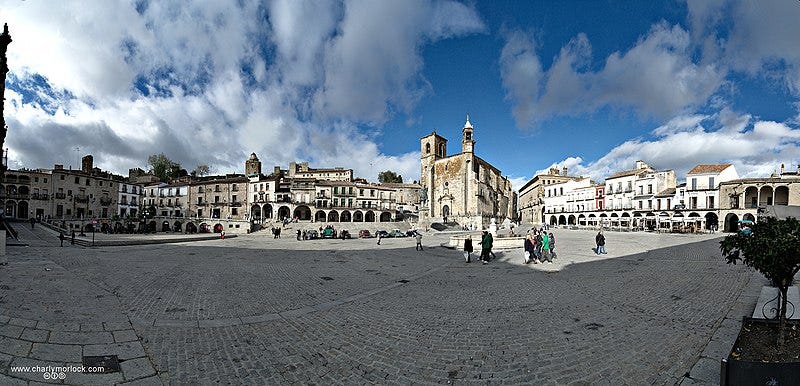A small town in Spain could play a pivotal role in developing of the world’s fastest microchips—if you believe a recent press release from the European Commission.
The place is called Trujillo, located in an area known as La España vacía (“empty Spain”). This part of the country missed out on much of the industrialization and tourism other regions enjoyed.
A California-based company called Diamond Foundry—Leonoardo DiCaprio is an early investor—is behind this project. The company is currently constructing a wafer fab near this town, which dates back to at least Roman times.
Here’s how the European Commission describes it:
The plant will produce rough synthetic diamond wafers using the company's plasma reactor technology. Synthetic diamonds can be used in the semiconductor industry as an alternative to other resources currently used, such as silicon. The project aims at serving the demand of key sectors, such as 5G networks or electric vehicles.
Diamond microchips! That’s both glamorous and sci-fi.
And they’ll be made near an ancient town by a company partly owned by Leonardo DiCaprio? Sounds like a true oddball project.
One that deserves having a closer look.
If nothing else, it’s a masterclass in how to pocket subsidies—a playbook your business (or your clients’) could follow.
The Holy Grail in Chip Performance🏆
Diamond Foundry says it’s working on a solution to make microchips run faster, consume less energy, take up less space, or do all of that combined.
At the core of this challenge lies one crucial factor: heat.
Heat is generated by the power semiconductors consume. In fact, it’s one of the main bottlenecks limiting a computer’s speed. As Andy Bechtolsheim, co-founder of Sun Microsystems, puts it, “The hard limit on chip performance is the maximum temperature on a chip.”
With AI demanding ever more computing power, solving the heat problem holds enormous economic value. After all, cooling systems account for roughly 40% of a modern data center’s electricity consumption.
As the name suggests, Diamond Foundry plans to tackle the heat issue with diamonds. These gemstones are the best-known conductors of heat. But here’s the catch: no one makes microchips out of them.
The company claims to have developed the technology to create the world’s first diamond wafer—a single, artificially grown diamond crystal, 100 mm in diameter and weighing 110 carats.
The idea is to mate this wafer with silicon microchips, allowing the heat to quickly dissipate.
Thanks to this approach, chips are expected to run faster without failing. Using this method on one of Nvidia’s GPUs, Diamond Foundry engineers claims they’ve managed to triple its speed under lab conditions.
But don’t get too excited just yet.
“Diamond Chips” Might be 5-10 Years Away ☹️
If this is really working, industry interest should be massive. According to the Wall Street Journal:
[Founder] Roscheisen says that his company is in talks with most of the world’s biggest chip manufacturers, as well as a number of defense contractors and electric-vehicle makers.
This WSJ piece is from November 2023. As of today, there are no updates on the company’s website regarding how those talks are going.
In fact, it’s unlikely that chip makers will adopt diamond wafers anytime soon—although they might be intrigued by the idea.
That’s because semiconductor manufacturing relies on well-established, highly optimized production systems that can’t be quickly altered. Implementing diamond wafers into this process would likely take years.
And chipmaker are unlikely to bother if there’s no reliable supply of diamond wafers.
Diamond Foundry’s plant in Spain is expected to produce around 4 to 5 million carats per year.
That’s just one metric ton.
For context, global silicon production reached an estimated nine million metric tons in 2023. In other words, the plant’s output would be like pouring two pints of water into an Olympic-sized swimming pool.
A Dream Come True for Bureaucrats 🤤
None of this stopped Spain from granting €81 million toward the plant’s construction (the total investment is estimated at around €675 million).
In semiconductor terms, that’s pocket change. For comparison, TSMC secured €5 billion in German state aid—covering roughly half the cost of its planned €10+ billion semiconductor facility in Dresden.
Still, Diamond Foundry offers a neat three-step case study on how to get bureaucrats excited about your project.
Interested in learning how to secure a good chunk of government funding? Keep reading.
Step #1: Meet a Pressing Demand 🔥
… Or at least position yourself so it looks like you meet such a demand.
Right now, anything semiconductor related is hot:
Covid exposed supply chain vulnerability, ramping up the push to onshore critical industries.
AI is driving demand for ever-increasing computing power.
There’s an oingoing chip race between China and the West.
Diamond Foundry popped up at exactly the right time.
But here’s the kicker: the company didn’t start out positioning itself as a “semiconductor-grade synthetic diamond” maker.
Instead, it began as a producer of “jewelry-grade diamonds.” The company even bought jewelry brand Vrai in 2016.
Here’s how TechCrunch described the company’s unique selling proposition—and the reason for Leonoardo DiCaprio’s investment in 2015:
DiCaprio says he’s drawn to Diamond Foundry’s aim of “reducing the human and environmental toll of the diamond industry by sustainably culturing diamonds without the destructive use of mining.”
Indeed, the traditional diamond mining industry has long been plagued by reports of human rights abuses, including the forced labor of children in diamond fields. And there are environmental consequences that result from the removal and logging of tons of earth in pursuit of diamonds.
Its current website makes no mention of the jewelry business.
Yet, since the company hasn’t listed a single tech client, it’s reasonable to assume that most of its revenue still comes from selling “jewelry-grade diamonds.”
The company pivoted when it acquired Augsburg Diamond Technology, also known as Audiatec, in late 2022. This firm specializes in the synthesis of single-crystal diamonds for ultra-precision tools, but also markets diamond wafers on its website.
If it’s jewelry vs. microchips, the latter is much more likely to tickle politicians’ fancy.
So, when shopping for subsidies, keep the positioning of your company in mind.
Ticking the next box is almost compulsory if you want to unlock EU cash…
Step #2: Invoke The Mantra of Sustainability 🌱
The company says it uses “plasma reactor technology” to crystallize greenhouse gases into diamonds. More specifically, it’s turning methane—which is even worse for the atmosphere than CO₂—into diamonds.
And it gets even better: The Trujillo plant is set to run exclusively on renewable energy. This will require the construction of a 120 MW solar plant with battery storage. Diamond Foundry is working with Spanish energy supplier Powen on this project.
The company didn’t disclose the plant’s battery storage capacity. However, given that plasma reactors typically consume a significant amount of energy, it must be substantial. After all, solar’s capacity factor in Spain is just above 20%. So, it’s either a huge battery bank, or Diamond Foundry has a grid connection—“just in case.”
The next step might be the most important one when it comes to maximizing the subsidies you can pocket…
Step #3: Pick The Correct Region 🧭
According to one newspaper article, Leonardo DiCaprio chose Trujillo over options in China and the United Arab Emirates because it’s so sunny.
Maybe the company let Leonardo think his input mattered, but it’s much more likely Trujillo won the bid due to something called “Regional Aid Maps.”
These maps identify regions eligible for higher levels of state aid based on their low economic performance relative to EU averages.
The percentage of project costs that companies can have subsidized in these regions is higher than what is typically allowed. You can access the maps valid until 2027 here.
Trujillo is located in the autonomous community of Extremadura, which, of course, qualifies for increased aid according to Spain’s Regional Aid Maps.
Companies in these areas still have to meet the specific criteria of the domestic aid programs in order to receive investment aid, but these maps can serve as helpful starting points for assessing potential sites.
So They Just Want to Pocket Subsidies?💰
Diamond Foundry is definitely a legit company, but when it comes to semiconductors, it’s probably more akin to a big R&D project next to its income stream from the jewelry business.
Its founder, Martin Roscheisen, is a serial entrepreneur who has started several companies that were later acquired by big players. Maybe he’s planning for Diamond Foundry to be acquired by a giant such as TSMC or Samsung—if the technology proves to be sufficiently promising.
Strategic Insights ♟️
The takeaway for investors, founders, and legal counsel is that positioning, ticking the correct policy boxes, and selecting the right region for a project can lead to a substantial subsidy that helps get a project off the ground in the EU.
Local policymakers may have money set aside for development projects, but they might not always know how to spend it. It’s unlikely that Trujillo’s mayor was aware that diamond wafers even exist.
Therefore, it’s worth reaching out to the political entities governing the areas highlighted in the “Regional Aid Maps” to find out about state aid schemes. If an appropriate program doesn’t exist, it might make sense to “pitch” a project. Authorities could create a new scheme to fit your needs if the project is large enough.







